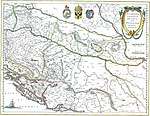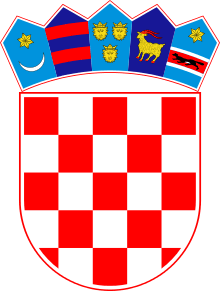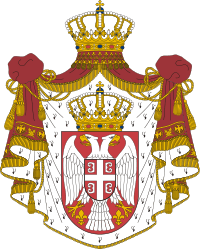Zachlumia
Zachlumia or Zachumlia (Serbo-Croatian: Zahumlje / Захумље; pronounced [zǎxuːmʎe]), also Hum, was a medieval principality located in the modern-day regions of Herzegovina and southern Dalmatia (today parts of Bosnia and Herzegovina and Croatia, respectively). In some periods it was a fully independent or semi-independent South Slavic principality. It maintained relations with various foreign and neighbouring powers (Byzantine Empire, First Bulgarian Empire, Kingdom of Croatia, Principality of Serbia) and later was subjected (temporarily of for a longer period of time) to Kingdom of Hungary, Kingdom of Serbia, Kingdom of Bosnia, Duchy of Saint Sava and at the end to the Ottoman Empire.
Principality of Zachlumia Захумље Zahumlje | |||||||||||
|---|---|---|---|---|---|---|---|---|---|---|---|
| 9th century–1054 | |||||||||||
 Zachlumia in 9th century | |||||||||||
| Religion | Christianity | ||||||||||
| Government | Monarchy | ||||||||||
| Prince | |||||||||||
• 910–935 | Michael (first known) | ||||||||||
• 1039–1054 | Ljutovid (last independent) | ||||||||||
| History | |||||||||||
• Established | 9th century | ||||||||||
• Conquered by Duklja | 1054 | ||||||||||
| |||||||||||
| Today part of | |||||||||||
Etymology
Zachlumia is a derivative of Hum, from Proto-Slavic *xŭlmŭ, borrowed from a Germanic language (cf. Proto-Germanic *hulma-), meaning "Hill".[1] South Slavic Zahumlje is named after the mountain of Hum (za + Hum "behind the Hum"), above Bona, at the mouth of the Buna. The principality is named Zahumlje or Hum in Serbo-Croatian (Serbian Cyrillic: Захумље, Хум). It is Zachlumia in Latin, Хлъмъ in Old Church Slavonic, and Ζαχλούμων χώρα ("land of Zachlumians") in Greek. The names Chelmania, Chulmia and terra de Chelmo appear in later Latin and Italian chronicles.
Geography
De Administrando Imperio described the polity of Zachlumia, likely during the reign of Časlav Klonimirović (r. 927–960): "From Ragusa begins the domain of the Zachloumoi (Ζαχλοῦμοι) and stretches along as far as the river Orontius; and on the side of the coast it is neighbour to the Pagani, but on the side of the mountain country it is neighbour to the Croats on the north and to Serbia at the front ... The Zachloumoi that now live there are Serbs, originating from the time of the prince (archon) who fled to emperor Heraclius ... The land of the Zachloumoi comprise the following cities: Ston (το Σταγνον / to Stagnon), Mokriskik (το Μοκρισκικ), Josli (το Ιοσλε / to Iosle), Galumainik (το Γαλυμαενικ / to Galumaenik), Dobriskik (το Δοβρισκικ / to Dovriskik)"
The Chronicle of the Priest of Duklja (14th or 16th century) described the geography under the rule of the South Slavic rulers, Hum had two major cities: Bona and Hum. The main settlements in Zachlumia were Ston, Ošlje, Dobar, the towns of Mokriskik and Glumainik. The Principality sprang from Dalmatia (Croatia) to the northwest and Pagania to the west; to the mountain of Kalinovik and the Field of Gatak, where it bordered Travunia. The most eastern border of Zahumlje went along the line Popovo-Ljubinje-Dabar and met with the Travunian border at the city of Ragusa, which had to pay the annual tax mogorish of 36 pieces of gold to the Zachlumian rulers and at times accept their rule. Zachlumia was split on 9 zhupanates: Ston, Popovo, Dubrava, Luka, Dabar, Žapska, Gorička and Večenik around Neretva. Zahumlje had access to the Adriatic Sea with the Pelješac peninsula and faced Serbia northwards.
In its later periods, Zahumlje was split into two Duchies: Upper Zahumlje in the west and Lower Zahumlje in the east.
As the toponym Pagania disappeared by the turn of the 11th century, the land of Hum was expanded to include the territory between Neretva and Cetina previously referred to as Pagania. This territory was at the time controlled by local magnates called Radivojevići, Jurjevići or Vlatkovići.[2]
Slavic settlement
Slavs invaded Balkans during Justinian I (r. 527–565), when eventually up to 100,000 Slavs raided Thessalonica. The Western Balkans was settled with Sclaveni (Sklavenoi), the east with Antes.[3] The Sklavenoi plundered Thrace in 545, and again the next year. In 551, the Slavs crossed Niš initially headed for Thessalonica, but ended up in Dalmatia.[4] In 577 some 100,000 Slavs poured into Thrace and Illyricum, pillaging cities and settling down.[5] Hum had also a large number of Vlachs who were descendent from a pre-Slavic population. Related to Romanians and originally speaking a language related to Romanian, the Vlachs of what was Hum are today Slavic speaking.[6]
History
Part of a series on the |
|---|
| History of Herzegovina |
|
|
|
7th century
In the second decade of the 7th century, the Avars and their Slavic subjects occupied most of the Byzantine province of Dalmatia, including the territory of what would become Zahumlje, sacking towns and enslaving or displacing the local population. Some of the Slavs and Avars might have permanently settled in the occupied areas. They attacked Constantinople in 626 but were defeated by the Byzantines, after which the Avars ceased to play a significant role in the Balkans.[7]
Around 630, during the reign of Byzantine Emperor Heraclius, Serbs and Croats (Slavic tribes) led by their respective aristocracies entered the western Balkans from the north, which was approved by the emperor. They inhabited areas that had been devastated by the Avars, where Byzantium (East Roman Empire) had generally been reduced to only nominal rule. According to DAI, Zahumlje was one of the regions settled by the Serbs from an area near Thessaloniki previously arrived there from White Serbia but Tibor Živković and Neven Budak consider that a closer reading of the source suggests that the Constantine VII's consideration about the region population ethnic identity is based on Serbian political rule and does not indicate ethnic origin.[8][9][10] Much of Dalmatia was sometime earlier settled by the Croats, and Zahumlje bordered their territory on the north.[11]
The historical work Historia Salonitana by Thomas the Archdeacon, when describing the reign of Croatian king Stephen Držislav in the late 10th century, notes that Duchy of Hum (Zachlumia or Chulmie) was a part of the Kingdom of Croatia, before and after Stjepan Držislav.
"Istaque fuerunt regni eorum confinia: ab oriente Delmina, ubi fuit civitas Delmis, ... ab occidente Carinthia, versus mare usque ad oppidum Stridonis, quod nunc est confinium Dalmatie et Ystrie; ab aquilone vero a ripa Danubii usque ad mare Dalmaticum cum tota Maronia et Chulmie ducatu."
"The boundaries of that kingdom were as follows. To the east: Delmina. ... To the west: Carinthia, towards the sea up to the town of Stridon, which now marks the boundary between Dalmatia and Istria. To the north, moreover: from the banks of the Danube down to the Dalmatian sea, including all of Maronia and the Duchy of Hum."
9th century
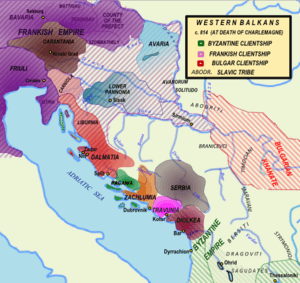

Charlemagne, King of the Franks from 768 until his death in 814, expanded the Frankish kingdom into an empire (800) that incorporated much of western and central Europe.[13] He brought the Frankish state face to face with the West Slavs to the northeast and the Avars and South Slavs to the southeast of the Frankish empire.[13] Dalmatia which was southeast of the Frankish empire, was chiefly in the hands of South Slavic tribes.[14] North of Dubrovnik these came to be under Croatian župans (princes) and eventually came to consider themselves Croatians, while many of those to the south of Dubrovnik were coming to consider themselves Serbs.[14] Despite Frankish overlordship, the Franks had almost no role in Dalmatia (Dalmatian Croatia and Zahumlje) in the period from the 820s through 840s.[15]
In 866, a major Arab raid along Dalmatia struck Budva and Kotor, and then laid siege to Dubrovnik in 867.[15] The city of Dubrovnik appealed to Byzantine Emperor Basil the Macedonian, who responded by sending over one hundred ships.[15] Finally, the 866–867 Saracens' siege of Dubrovnik, which lasted fifteen months, was raised due to the intervention of Basil I, who sent a fleet under the command of Niketas Oryphas in relief of the city.[16] After this successful intervention, the Byzantine navy sailed along the coast collecting promises of loyalty to the empire from the Dalmatian cities.[15] At this moment the local Slavic tribes (in Zahumlje, Travunija, and Konavle), who had aided the intervention, also accepted Byzantine suzerainty.[15] Afterwards, the Slavs of Dalmatia and Zahumlje took part in the Byzantine military actions against the Arabs in Bari in 870-871.[15] The Roman cities in Dalmatia had long been pillaged by the Slavic tribes in the mountaines around them.[15] Basil I allowed the towns to pay tribute to the Slavic tribes to reduce the Slavs raiding.[15] Presumably a large portion of this tribute went to the prince of Dalmatian Croatia.[15] In late 870s, the theme of Dalmatia ("thema Dalmatias") was established, but with no real Byzantine authority.[17] These small cities in the region (also Dyrrachium) did not stretch into the hinterlands, and had none military capacity, thus Basil I paid a tax of '72 gold coins' to the princes of Zahumlje and Travunia.[17]
In 879, the Pope asked for help from Croatian prince Zdeslav for an armed escort for his delegates across southern Dalmatia and Zahumlje. Later in 880, the Pope ask the same from Zdeslav's successor, prince Branimir.
10th century
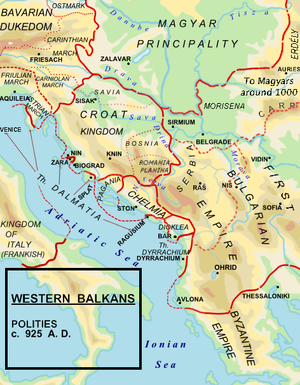
The history of Zahumlje as a greater political entity starts with the emerging of Michael of Zahumlje, an independent South Slavic ruler who flourished in the early part of the 10th century. A neighbour of Croatian Kingdom and Principality of Serbia as well as an ally of Bulgaria, he was nevertheless able to maintain independent rule throughout at least a good part of his reign.[18]
Michael have come into territorial conflict with the neighbouring prince Peter Gojniković, the ruler of inner Serbia, who was extending his power westwards.[19][20] To eliminate that threat and as a close ally of Bulgaria, Michael warned the Bulgarian Tsar Simeon I about the alliance between Peter and Symeon's enemy, the Byzantine Empire.[19] In 912 Michael kidnapped the Venetian Doge's son Peter Badoari that was returning to Venice from Constantinople and sent him to Czar Simeon as a sign of loyalty. Symeon attacked inner Serbia and captured Peter, who later died in prison, and Michael was able to restore the majority of control.[21] Before the annexation of inner Serbia in 924, Bulgaria did not yet border on Zahumlje, but a part of Croatia lay between both lands. The Venetian chronicler John the Deacon (d. 1009) says that in 912 during Michael's rule, Zachlumia was a part of the Croatian land.[22]
The Historia Salonitana maior, whose composition may have begun in the late 13th century,[23] cites a letter of Pope John X to Tomislav, "king (rex) of the Croats", in which he refers to the first council in some detail. If the letter is authentic, it shows that the council was attended not only by the bishops of Croatian and Byzantine Dalmatia, but also by Tomislav, whose territory also included the Byzantine cities of Dalmatia, and by a number of Michael's representatives. Zahumlje may have been under Croatian influence, but remained a separate political entity. Both Zahumlje and Croatia were under the religious jurisdiction of the Archbishopric of Split. In this letter, John describes Michael as "the most excellent leader of the Zachlumi" (excellentissimus dux Chulmorum).[24][25]
After the Italian city of Siponto (Latin: Sipontum) was heavily jeopardized by the raiding Arabs and Langobards, Mihailo won a magnificent military victory by taking the city upon the recommendations from Constantinople and orders from his ally, King Tomislav Trpimirovic, but didn't keep it permanently.[26] Mihailo Višević entered into closer relations with the Byzantine Empire, after the death of Bulgaria's Tsar Simeon. He gained the grand titles of the Byzantine court as anthypatos and patrician (patrikios).[21] He remained as ruler of Zahumlje into the 940s, while maintaining good relations with the Papacy.[27]
The historical work Historia Salonitana by Thomas the Archdeacon, when describing the reign of Croatian king Stephen Držislav in the late 10th century, notes that Duchy of Hum (Chulmie) was a part of the Kingdom of Croatia, before and after Stjepan Držislav.[12]
After the death of Mihailo, Zahumlje came under the rule of Serbian prince Časlav Klonimirović, the last of the Vlastimirović dynasty. With the death of Časlav, Serbia disintegrated and in 11th century Duklja absorbed most of Raška along with Zahumlje and Travunija.[28]
In the 990s, Bulgarian Tsar Samuel made client states out of most of the Balkans, including Duklja and Zahumlje.[29] In 998, Samuel launched a major campaign against Jovan Vladimir to prevent a Byzantine-Serbian alliance, resulting in a surrender.[30] The Bulgarian troops proceeded to pass through Dalmatia, taking control of Kotor and journeying to Dubrovnik. Although they failed to take Dubrovnik, they devastated the surrounding villages. The Bulgarian army then attacked Croatia in support of the rebel princes Krešimir III and Gojslav and advanced northwest as far as Split, Trogir and Zadar, then northeast through Bosnia and Raška and returned to Bulgaria.[30] The Croato-Bulgarian War allowed Samuel to install vassal monarchs in Croatia.
11th century
In a charter dated July 1039, Ljutovid of Zahumlje who was an independent Slavic ruler of Zahumlje, styled himself "Ljutovit, protospatharios epi tou Chrysotriklinou, hypatos, strategos" of Serbia and Zahumlje, which suggests the Byzantine Emperor granted him nominal right over neighbouring lands, including Duklja.[31] Ljutovid's claim to be strategos not only of Zahumlje, but all Serbia suggests that he had been courted by the emperor, and awarded nominal rights neighbouring lands, including Duklja, which was at the time at war with the empire.[31] If we can trust the Chronicle of the Priest of Duklja, our only narrative source, we must conclude that none of the Serbian lands was under direct Byzantine control in 1042.[31] Vojislav of Duklja (fl. 1018-1043) soon took Zahumlje from the Byzantines.[32] During the rule of Constantine Bodin (r. 1081–1101), neither Bosnia, Rascia nor Zahumlje was ever integrated into Doclea, each retained its own nobility and institutions and simply acquired a Vojislavljević to head the local structure as Prince or Duke.[33] Zahumlje subsequently became part of the Grand Principality of Serbia.
12th century

Kočapar, the Prince of Duklja (r. 1102–1103), ruled in the name of Vukan I of Serbia. There was a split between the two, and Vukan sent forces to Duklja, making Kočapar flee to Bosnia and then Zahumlje, where he died.[34] Zavida ruled Zahumlje before getting into a conflict with his brothers, resulting in him being exiled to Duklja, where he would have the title of Lord of Ribnica.[35] Grand Princes Desa (r. 1148-1162) and Uroš II Prvoslav ruled Serbia together 1149-1153; Desa had the title of 'Prince of Duklja, Travunija and Zahumlje', mentioned in 1150 and 1151.[36]
About 1150, the Byzantine Emperor Manuel I Komnenos displeased with king Radoslav of Duklja, divided up his lands between princes of the old Serbian family of Zavida, and Stefan Nemanja secured the land of Hum.[37] After 1168 when Nemanja was raised to the Serbian throne with Manuel's favor, Hum passed to his brother Miroslav.[37] He married a sister of Ban Kulin, who in meantime acquired the throne of Bosnia.[37] The subjects of Miroslav and Kulin included both Catholic and Orthodox.[37] Prince Miroslav himself was Orthodox.[38] In meantime, both Bosnia and Hum had been fought between Kingdom of Hungary and Byzantine Empire.[37] The Catholics supported the former and the Orthodox the latter.[37] A support of the growing heresy seemed the best solution for both Kulin and Miroslav.[37]

Following the death of Emperor Manuel in 1180 Miroslav started ecclesiastical superior of Hum.[39] He refused to allow Rainer, Latin Archbishop of Spalato (Split) whom he considered to be an agent of Hungarian king, to consecrate a bishop for the town of Ston.[39] In addition, Miroslav confiscated the Archbishop's money.[39] Rainer complained to the Pope Alexander III, who sent Teobald to report on the matter.[39] The Pope's nuncio Teobald found Miroslav as a patron of heretics.[39] After this, the Pope wrote to king Béla III of Hungary who was overlord of Hum (which Miroslav did not recognize), telling him to see that Miroslav performed his duty, but Miroslav remained as Prince of Hum.[39] In 1190-1192, Stefan Nemanja briefly assigned the rule of Hum to his son Rastko Nemanjić, while Miroslav held the Lim region with Bijelo Polje.[40] Rastko however took monastic vows and Miroslav continued ruling Hum after 1192.[40]
Latin vengeance came in March 1198, when Andrew II of Hungary become the prince of Dalmatia, Croatia and Hum, while Miroslav died a year after and his wife was living in exile.[39] The Miroslav Gospels are the oldest surviving documents written in Serbian recension of Old Church Slavonic, very likely produced for the Church of St Peter in Lima, commissioned by prince Miroslav.[41]
13th century
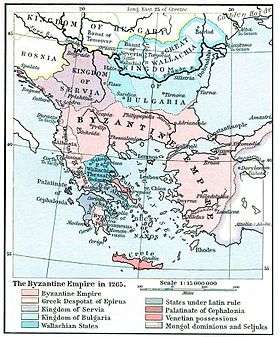
Until beginning of the 13th century, areas of Zahumlje were under jurisdiction of the Roman Church.[42] When Sava became the first Archbishop of Serbs in 1219, he appointed Ilarion as Orthodox Bishop of Hum.
Andrija Mirosavljević is entitled the rule of Hum, but the Hum nobility chose his brother Petar. Andrija is exiled to Rascia, to the court of his cousin, the Grand Prince Stefan Nemanjić. In the meantime, Petar fought successfully with neighbouring Bosnia and Croatia. Stefan Nemanjić sided with Andrija and went to war and secured Hum and Popovo field for Andrija sometime after his accession. Petar was defeated and crossed the Neretva, continuing to rule the west and north of the Neretva, which had around 1205 been briefly occupied by Andrew II of Hungary.[43][44] Toljen Toljenović, the son of Toljen I, succeeded as Prince, ruling 1227-1237. Andrija's sons Bogdan, Radoslav and Djordje succeed as Princes of Hum in 1249, Radoslav held the supreme rule. During the war against Ragusa, he aided his kinsman Stephen Uroš I of Serbia, at the same time swearing allegiance to Béla IV of Hungary. Following an earthquake in the Hum capital of Ston, the Serbian Orthodox bishop of Hum moved to the church of St Peter and St Paul built on the Lim River near the Serbian border in the 1250s.[43]
Radoslav of Zahumlje was from 1254 a vassal of Hungary, but probably afterwards his land were absorbed into Serbia.[45] However, he was at war with Serbia in 1268, while still under Hungarian suzerainty.[46] But seeking to centralize his realm, Stephen Uroš I of Serbia tried to stamp out regional differences by dropping references to Zahumlje (Hum), Trebinje and Duklja (Zeta), and called himself "King of all Serbian land and the Coast".[46] Miroslav's descendants dropped to the level of other local nobles.[46]
14th century
Paul I Šubić of Bribir as Ban of Croatia and Dalmatia controlled Croatia from Gvozd Mountain to the river Neretva mouth.[47] Paul became Lord of all of Bosnia in 1299.[48] Although supporting the king, Paul continued to act independently, and ruled over a large portion of modern-day Croatia and Bosnia.[48] In the course of the war between Stephen Uroš II Milutin and Stephen Dragutin, Paul Šubić expanded not only into western Hum, but also beyond the Neretva river, and took the region of Nevesinje and Ston.[17] In 1312, Hum was added to the title of Mladen II Šubić, who succeeded Paul.[17] At least part of Paul's conquests were granted to his vassal Constantine Nelipčić.[17] After Paul's death, Milutin and Dragutin concluded a peace, and went to war against Šubić family.[17] In the war that followed Milutin took one of Mladen's brother captive, and to get him back Mladen Šubić had to agree to restore a part of Hum to Milutin.[17] After this agreement in 1313 the Neretva again became the border between eastern and western Hum.[17]
By 1325, the Branivojević family had emerged as strongest in Hum.[49] Probably at their highest point they ruled from Cetina River to the town of Kotor.[49] Though nominal vassals of Serbia, the Branivojević family attacked Serbian interests and other local nobles of Hum, who in 1326 turned against Serbia and Branivojević family.[49] The Hum nobles approached to Stjepan Kotromanić II, the ban of Bosnia, who then annexed most of Hum.[49] The Draživojevići of Nevesinje as vassals of Bosnian Ban, become the leading family of Hum in the 1330s.[50] Because of the war in 1327-1328 between Serbia and Dubrovnik, Bosnian lordship of inner Hum and the war in Macedonia, Stephen Uroš IV Dušan sold Ston and Pelješac to Dubrovnik, and turned to the east to acquire all of Macedonia.[50]
The region was overwhelmed by the House of Kotromanić from Bosnia in 1322-1326. By the mid-14th century, Bosnia apparently reached a peak under Ban Tvrtko I who came into power in 1353.
15th century
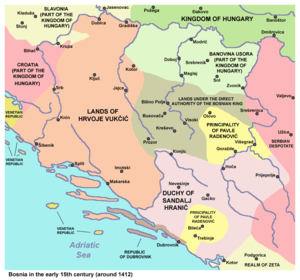
In the beginning of the 15th century, Hrvoje Vukčić Hrvatinić ruled over the western Hum, and Sandalj Hranić Kosača ruled over its eastern part, while the Neretva river remain a border between their possessions.[51]
Bosnian regional lord Stjepan Vukčić Kosača who ruled over Zahumlje, in 1448 dropped his title "Vojvode of Bosnia", assuming the title "Herceg [Duke] of Hum and the Coast".[52] He changed it again in 1449 to "Herceg of Saint Sava" in recollection of the Serbian saint.[52] This title had considerable public relations value, because Sava's relics were consider miracle-working by people of all Christian faiths.[52] His lands were known as Herzog's lands or later Herzegovina.[52]
In 1451 he attacked Dubrovnik, and laid siege to the city.[53] He had earlier been made a Ragusan nobleman and, consequently, the Ragusan government now proclaimed him a traitor.[53] A reward of 15,000 ducats, a palace in Dubrovnik worth 2,000 ducats, and an annual income of 300 ducats was offered to anyone who would kill him, along with the promise of hereditary Ragusan nobility which also helped hold this promise to whoever did the deed.[53] Stjepan was so scared by the threat that he finally raised the siege.[53]
Demographics
12th–13th centuries
Most of Hum's territory was inhabited by Serbs and Vlachs and belonged to the Eastern Church after the Great Schism (under the Archbishop of Ohrid until 1219, and afterwards under the Serbian Orthodox Church).[54] Hum's coastal region, including its capital Ston, had a mixed population of Catholics and Orthodox.[38][54]
14th–15th centuries
In contrast to Bosnia, where Roman Catholicism and Bogomilism (see Bosnian Church) was firmly established, eastern parts of Hum was mostly Orthodox, from 13th century and the rise of Nemanjići. The Bishopric of Hum, seated in Ston (1219-1250), and after that in Lim, was part of the Archbishopric of Serbia. The Catholic West referred to Hum Orthodox Christians as "Greeks" and "Rascians" (Graeci, Rasciani) or "schismatics", with the Orthodox religion being called "Rascian religion". The Hum Orthodox came into conflict with the Catholics, especially during the last years of the Bosnian Kingdom.[55]
In the 14th- and 15th centuries, there was an influx of settlers from the oblasts of Trebinje (the region around forts Klobuk Ledenica and Rudina) and the Hum lands (Gacko and Dabar) to Kotor. The people from Hum were mostly girls from Gacko, who took up working as servants to wealthy families.[56]
List of rulers
|
- Michael of Zahumlje, independent Slavic ruler of Zahumlje, Prince of Zahumlje 910–940[27]
- Časlav, knez of Serbia 940–960
- Tihomir, knez of Serbia 960–969
- Stephen Držislav of Croatia, King of Croatia 969–997[12]
- Dragimir, Prince of Travunia and Zachlumia (as a part of Duklja) 1000–1018
- Part of Byzantine empire: 1018–1039
- Ljutovid, Prince of Hum 1039–1054
- Mihajlo Vojislavljević, Prince, and King of Duklja 1054–1081
- Bodin Vojislavljević, King of Duklja 1081–1101
- Vladimir II of Duklja, King of Duklja c. 1103–1113
- George I of Duklja, King of Duklja c. 1113–1118 and 1125–1131
- Desa, Duke of Zahumlje 1149–1162
- Miroslav of Hum Prince of Zahumlje 1162–1190
- Rastko of Nemanja 1190–1192 ruling in the name of Stefan Nemanja
- Miroslav of Hum Prince of Zahumlje 1192
- Toljen of Hum Prince of Zahumlje 1192–1196 (He married a daughter of Duke Berthold von Meran, Margrave of Istria)
- To Hungary 1198–1199[39]
- Petar, son of Miroslav, Duke of Zahumlje 1196–1216 and a count of the city of Split 1222–1225.
- In 1216 Stephen the First-Crowned divided Hum:
- Union of Zachlumia:
- Andrija, 1239–1250
- Radoslav of Zahumlje, Bogdan I and George I 1249–1252 (brothers, sons of Andrew)
- Radoslav of Zahumlje and George I 1252–1268
- George I 1268–1280
- Bogdan II 1280–1299
- Mladen I Šubić of Bribir, a Croatian noble and Bosnian Ban from 1299–1304[57]
- Paul I Šubić of Bribir, a Ban of Croatia and Lord of all of Bosnia from 1304–1312[57]
- Mladen II Šubić of Bribir, "Ban the Croats and Bosnia and general lord of Hum country" 1312–1322[58]
- Nikola, Prince of Zahumlje 1322–1326. Son of Bogdan I (or Radoslav). He married Katarina Kotromanić in 1338
- Stjepan Kotromanic II, a Bosnian Ban from 1326–1353
- Tvrtko, the first Bosnian King 1353–1391
- Stephen Dabiša of Bosnia 1391–1395
- Helen I 1395–1398
- Stephen Ostoja of Bosnia 1398– 1404[59]
- Stephen Tvrtko II of Bosnia 1404–1409
- Stephen Ostoja of Bosnia (again) 1409–1418[59]
- Sandalj Hranić Kosača, Grand Duke of Hum from 1418–1435
- Stjepan Vukčić Kosača (1435–1466) was Serbian noble. In 1448. changed his title from "Vojvode of Bosnia" into "Herceg [Duke] of Hum and the Coast", and from 1449 into "Herceg of Saint Sava" .
- Vlatko Hercegović from 1466 to 1481
Legacy
The historical name of the region is officially represented in the name of the Eparchy of Zahumlje and Herzegovina of the Serbian Orthodox Church. Also, the honorific title Grand Voivode (Duke) of Zahumlije has been granted at times to junior members of the Petrović-Njegoš dynasty that ruled in Montenegro until 1918. The last grand duke of Zahumlije was Prince Peter of Montenegro, who died in 1932.[60]
See also
References
Footnotes
- Entry "холм" in М. Фасмер (1986), Этимологический Словарь Русского Языка (Москва: Прогресс), 2-е изд. — Перевод с немецкого и дополнения О.Н. Трубачёва.
- Korać, Dijana (December 2007). "Vjerske prilike na području knezova Jurjevića – Vlatkovića" (in Serbo-Croatian) (49). Zadar: Croatian Academy of Sciences and Arts. ISSN 1330-0474. Retrieved 2012-07-09. Cite journal requires
|journal=(help) - Hupchick 2002.
- Janković 2004, p. 39-61.
- J B Bury, History of the Later Roman Empire from Arcadius to Irene, Vol 2 L
- Fine 1994, p. 19.
- Fine 1991, p. 25.
- Živković, Tibor (2012). De conversione Croatorum et Serborum: A Lost Source. Belgrade: The Institute of History. pp. 161–162, 181–196.CS1 maint: ref=harv (link)
- Budak, Neven (1994). Prva stoljeća Hrvatske (PDF). Zagreb: Hrvatska sveučilišna naklada. pp. 58–61. ISBN 953-169-032-4.
Glavnu poteškoću uočavanju etničke raznolikosti Slavena duž jadranske obale činilo je tumačenje Konstantina Porfirogeneta, po kojemu su Neretvani (Pagani), Zahumljani, Travunjani i Konavljani porijeklom Srbi. Pri tome je car dosljedno izostavljao Dukljane iz ove srpske zajednice naroda. Čini se, međutim, očitim da car ne želi govoriti ο stvarnoj etničkoj povezanosti, već da su mu pred očima politički odnosi u trenutku kada je pisao djelo, odnosno iz vremena kada su za nj prikupljani podaci u Dalmaciji. Opis se svakako odnosi na vrijeme kada je srpski knez Časlav proširio svoju vlast i na susjedne sklavinije, pored navedenih još i na Bosnu. Zajedno sa širenjem političke prevlasti, širilo se i etničko ime, što u potpunosti odgovara našim predodžbama ο podudarnosti etničkog i političkog nazivlja. Upravo zbog toga car ne ubraja Dukljane u Srbe, niti se srpsko ime u Duklji/Zeti udomaćilo prije 12. stoljeća. Povjesničari koji su bez imalo zadrške Dukljane pripisivali Srbima, pozivali su se na Konstantina, mada im on nije za takve teze davao baš nikakve argumente, navodeći Dukljane isključivo pod njihovim vlastitim etnonimom.
- Sima M. Ćirković, SRBI MEĐU EUROPSKIM NARODIMA,(Serbs) 2008. http://www.mo-vrebac-pavlovac.hr/attachments/article/451/Sima%20%C4%86irkovi%C4%87%20SRBI%20ME%C4%90U%20EVROPSKIM%20NARODIMA.pdf #page=26-27
- Fine 1991, p. 32-33.
- Thomas of Split 2006, p. 60–61.
- Ross 1945, p. 212–235.
- Fine 1991, p. 253.
- Fine 1991, p. 257.
- Norris 1993, p. 24.
- Fine 1991, p. 258.
- Curta 2006, p. 210.
- Fine 1991, p. 149.
- Ćirković 2004, p. 18.
- Moravcsik 1967, p. 152-162.
- John the Deacon, Chronicon Venetum, ed. Pertz, pp. 22-3.
- Fine 2005, pp. 54–55: "John the Deacon [...] makes no mention of either council", "manuscript from the 16th century Historia Salonitana maior has long descriptions of the two councils" and "the labels of identity [...] represent views from no earlier than the late 13th century, and possibly the 14th, 15th and 16th"
- Vlasto 1970, p. 209.
- Ćirković 2004, p. 17.
- Omrčanin 1984, p. 24.
- Fine 1991, p. 160.
- Fine 1991, p. 193.
- Fine 1991, p. 274.
- Шишић 1928, p. 331.
- Stephenson 2003, p. 42-43.
- Zlatar 2007, p. 572.
- Fine 1991, p. 223.
- Fine 1991, p. 231.
- Fine 1994, p. 3.
- Cawley, Charles, BOSNIA: Toc283713263, Medieval Lands database, Foundation for Medieval Genealogy,
- Runciman 1982, p. 101.
- Fine 1975, p. 114.
- Runciman 1982, p. 102.
- Fine 1994, p. 20-21.
- Ćirković 2004, p. 19.
- Milenko Krešić, 2016, Religious situation in the Hum land (Ston and Rat) during the Middle Ages, {Do početka 20-ih godina 13. stoljeća prostori Humske zemlje bili su pod jurisdikcijom zapadne, odnosno rimske Crkve. "By the early 20's of the 13th century areas of Hum land were under the jurisdiction of Western ie Roman Church.} https://hrcak.srce.hr/index.php?show=clanak&id_clanak_jezik=247029 #page= 66
- Fine 1994, p. 52-54.
- Ćirković 2004, p. 37.
- Runciman 1982, p. 107.
- Fine 1994, p. 203.
- Fine 1994, p. 207-208.
- Fine 1994, p. 209-210.
- Fine 1994, p. 266.
- Fine 1994, p. 267.
- Zlatar 2007, p. 555.
- Fine 1994, p. 578.
- Viator (1978), pp. 388–389.
- Fine 1994, p. 20.
- Velikonja 2003, p. 38.
- Тошић 2005, p. 221-227.
- "Ranokršćanske i predromaničke crkve u Stonu" [Early Christian and pre-romanesque churches in Ston] (PDF). Građevinar (in Serbo-Croatian). Zagreb: Croatian Society of Civil Engineers. 58: 757–766. 2006. Retrieved 2011-02-18.
- Fine 1994, p. 258.
- Runciman 1982, p. 111.
- Ulla Tillander-Godenhielm (2005): The Russian Imperial Award System During the Reign of Nicolas II, p. 446.
Bibliography
- Bataković, Dušan T. (1996). The Serbs of Bosnia & Herzegovina: History and Politics. Paris: Dialogue.CS1 maint: ref=harv (link)
- Ćirković, Sima (2004). The Serbs. Malden: Blackwell Publishing.CS1 maint: ref=harv (link)
- Thomas of Split (2006). History of the Bishops of Salona and Split: Historia salonitanorum atque spalatinorum pontificum. Budapest: Central European University Press.CS1 maint: ref=harv (link)
- Moravcsik, Gyula, ed. (1967) [1949]. Constantine Porphyrogenitus: De Administrando Imperio (2nd revised ed.). Washington D.C.: Dumbarton Oaks Center for Byzantine Studies.CS1 maint: ref=harv (link)
- Curta, Florin (2006). Southeastern Europe in the Middle Ages, 500–1250. Cambridge: Cambridge University Press.CS1 maint: ref=harv (link)
- Fine, John Van Antwerp Jr. (1975). The Bosnian Church: A New Interpretation: A Study of the Bosnian Church and Its Place in State and Society from the 13th to the 15th Centuries. Boulder: East European Quarterly.CS1 maint: ref=harv (link)
- Fine, John Van Antwerp Jr. (1991) [1983]. The Early Medieval Balkans: A Critical Survey from the Sixth to the Late Twelfth Century. Ann Arbor, Michigan: University of Michigan Press.CS1 maint: ref=harv (link)
- Fine, John Van Antwerp Jr. (1994) [1987]. The Late Medieval Balkans: A Critical Survey from the Late Twelfth Century to the Ottoman Conquest. Ann Arbor, Michigan: University of Michigan Press.CS1 maint: ref=harv (link)
- Fine, John Van Antwerp Jr. (2005). When Ethnicity Did Not Matter in the Balkans: A Study of Identity in Pre-Nationalist Croatia, Dalmatia, and Slavonia in the Medieval and Early-Modern Periods. Ann Arbor, Michigan: University of Michigan Press.CS1 maint: ref=harv (link)
- Fleming, Thomas (2002). Montenegro: The Divided Land. Rockford, Illinois: Chronicles Press.CS1 maint: ref=harv (link)
- Hupchick, Dennis P. (2002). The Balkans: From Constantinople to Communism. New York: Palgrave.CS1 maint: ref=harv (link)
- Hupchick, Dennis P. (2017). The Bulgarian-Byzantine Wars for Early Medieval Balkan Hegemony: Silver-Lined Skulls and Blinded Armies. New York: Springer.CS1 maint: ref=harv (link)
- Janković, Đorđe (2004). "The Slavs in the 6th Century North Illyricum". Гласник Српског археолошког друштва. 20: 39–61.CS1 maint: ref=harv (link)
- John the Deacon, Chronicon Venetum, ed. G. H. Pertz (1846). Monumenta Germaniae Historica: Scriptores 7. Hanover. pp. 1-36: 22-3. Archived from the original on 2011-07-19. A later edition is that by G. Monticolo (1890), Rome: Forzani. The relevant passage is also found in Rački, F. (1877). Documenta historiae chroaticae periodum antiquam illustrantia. Zagreb. pp. 388 (no. 197.1 ).
- Luttwak, Edward N. (2009). The Grand Strategy of the Byzantine Empire. Harvard University Press.CS1 maint: ref=harv (link)
- Norris, H.T. (1993). Islam in the Balkans: religion and society between Europe and the Arab world. University of South Carolina Press. ISBN 978-0-87249-977-5.
- Omrčanin, Ivo (1984). Military History of Croatia. Dorrance.CS1 maint: ref=harv (link)
- Rački, Franjo (1861). Odlomci iz državnoga práva hrvatskoga za narodne dynastie. Beč: Klemm.CS1 maint: ref=harv (link)
- Ross, James Bruce (1945). "Two Neglected Paladins of Charlemagne: Erich of Friuli and Gerold of Bavaria". Speculum. 20 (2): 212–235. JSTOR 2854596.CS1 maint: ref=harv (link)
- Runciman, Steven (1982). The Medieval Manichee: A Study of the Christian Dualist Heresy. Cambridge University Press.CS1 maint: ref=harv (link)
- Runciman, Steven (1988). The Emperor Romanus Lecapenus and His Reign: A Study of Tenth-Century Byzantium. Cambridge University Press.CS1 maint: ref=harv (link)
- Samardžić, Radovan; Duškov, Milan, eds. (1993). Serbs in European Civilization. Belgrade: Nova, Serbian Academy of Sciences and Arts, Institute for Balkan Studies.CS1 maint: ref=harv (link)
- Sedlar, Jean W. (1994). East Central Europe in the Middle Ages, 1000-1500. Seattle: University of Washington Press.CS1 maint: ref=harv (link)
- Stephenson, Paul (2003). The Legend of Basil the Bulgar-Slayer. Cambridge: Cambridge University Press.CS1 maint: ref=harv (link)
- Stephenson, Paul (2004). Byzantium's Balkan Frontier: A Political Study of the Northern Balkans, 900–1204. Cambridge: Cambridge University Press.CS1 maint: ref=harv (link)
- Stoianovich, Traian (1994). Balkan worlds: the first and last Europe. M.E. Sharpe. ISBN 978-1-56324-033-1.
- Velikonja, Mitja (2003). Religious Separation and Political Intolerance in Bosnia-Herzegovina. College Station: Texas A&M University Press.CS1 maint: ref=harv (link)
- Viator (1978). Medieval and Renaissance Studies. University of California Press. ISBN 978-0-520-03608-6.
- Vlasto, Alexis P. (1970). The Entry of the Slavs into Christendom: An Introduction to the Medieval History of the Slavs. Cambridge: Cambridge University Press.CS1 maint: ref=harv (link)
- Zlatar, Zdenko (2007). The poetics of Slavdom: the mythopoeic foundations of Yugoslavia. Peter Lang. ISBN 978-0-8204-8135-7.
- Ostrogorsky, George (1956). History of the Byzantine State. Oxford: Basil Blackwell.CS1 maint: ref=harv (link)
- Тошић, Ђуро (2005). "Требињци и Захумљани у средњовјековном Котору". Истраживања: Филозофски факултет у Новом Саду. 16: 221–227.CS1 maint: ref=harv (link)
- Klaić, Nada (1989). Srednjovjekovna Bosna: Politički položaj bosanskih vladara do Tvrtkove krunidbe (1377. g.). Zagreb: Grafički zavod Hrvatske.CS1 maint: ref=harv (link)
- Шишић, Фердо, ed. (1928). Летопис Попа Дукљанина. Београд-Загреб: Српска краљевска академија.CS1 maint: ref=harv (link)
- Кунчер, Драгана (2009). Gesta Regum Sclavorum. 1. Београд-Никшић: Историјски институт, Манастир Острог.CS1 maint: ref=harv (link)
- Живковић, Тибор (2009). Gesta Regum Sclavorum. 2. Београд-Никшић: Историјски институт, Манастир Острог.CS1 maint: ref=harv (link)
- Živković, Tibor (2008). Forging unity: The South Slavs between East and West 550-1150. Belgrade: The Institute of History, Čigoja štampa.CS1 maint: ref=harv (link)
- Živković, Tibor (2010). "Constantine Porphyrogenitus' Source on the Earliest History of the Croats and Serbs". Radovi Zavoda za hrvatsku povijest u Zagrebu. 42: 117–131.CS1 maint: ref=harv (link)
- Živković, Tibor (2013a). "On the Baptism of the Serbs and Croats in the Time of Basil I (867–886)" (PDF). Studia Slavica et Balcanica Petropolitana (1): 33–53.CS1 maint: ref=harv (link)
- Živković, Tibor (2013b). "The Urban Landcape of Early Medieval Slavic Principalities in the Territories of the Former Praefectura Illyricum and in the Province of Dalmatia (ca. 610-950)". The World of the Slavs: Studies of the East, West and South Slavs: Civitas, Oppidas, Villas and Archeological Evidence (7th to 11th Centuries AD). Belgrade: The Institute for History. pp. 15–36.CS1 maint: ref=harv (link)
